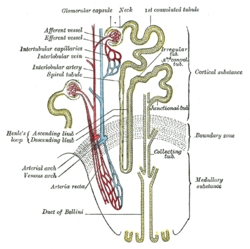Loop of Henle
| Loop of Henle | |
|---|---|

Scheme of renal tubule and its vascular supply. (Loop of Henle visible center-left.)
|
|
| Details | |
| Precursor | Metanephrogenic blastema |
| Identifiers | |
| Latin | Ansa nephroni |
| MeSH | A05.810.453.736.560.610 |
| Dorlands /Elsevier |
12138619 |
| FMA | 17698 |
|
Anatomical terminology
[]
|
|
In the kidney, the loop of Henle (English /ˈhɛnli/) (or Henle's loop, Henle loop,nephron loop or its Latin counterpart ansa nephroni) is the portion of a nephron that leads from the proximal convoluted tubule to the distal convoluted tubule. Named after its discoverer, the German anatomist Friedrich Gustav Jakob Henle, the loop of Henle's main function is to create a concentration gradient in the medulla of the kidney.
By means of a countercurrent multiplier system, which utilizes electrolyte pumps, the loop of Henle creates an area of high urea concentration deep in the medulla, near the papillary duct in the collecting duct system. Water present in the filtrate in the papillary duct flows through aquaporin channels out of the duct, moving passively down its concentration gradient. This process reabsorbs water and creates a concentrated urine for excretion.
The loop of Henle can be divided into four parts:
The tissue type of the loop is simple squamous epithelium. The "thick" and "thin" terminology does not refer to the size of the lumen, but to the size of the epithelial. The loop is also sometimes called the Nephron loop.
...
Wikipedia
